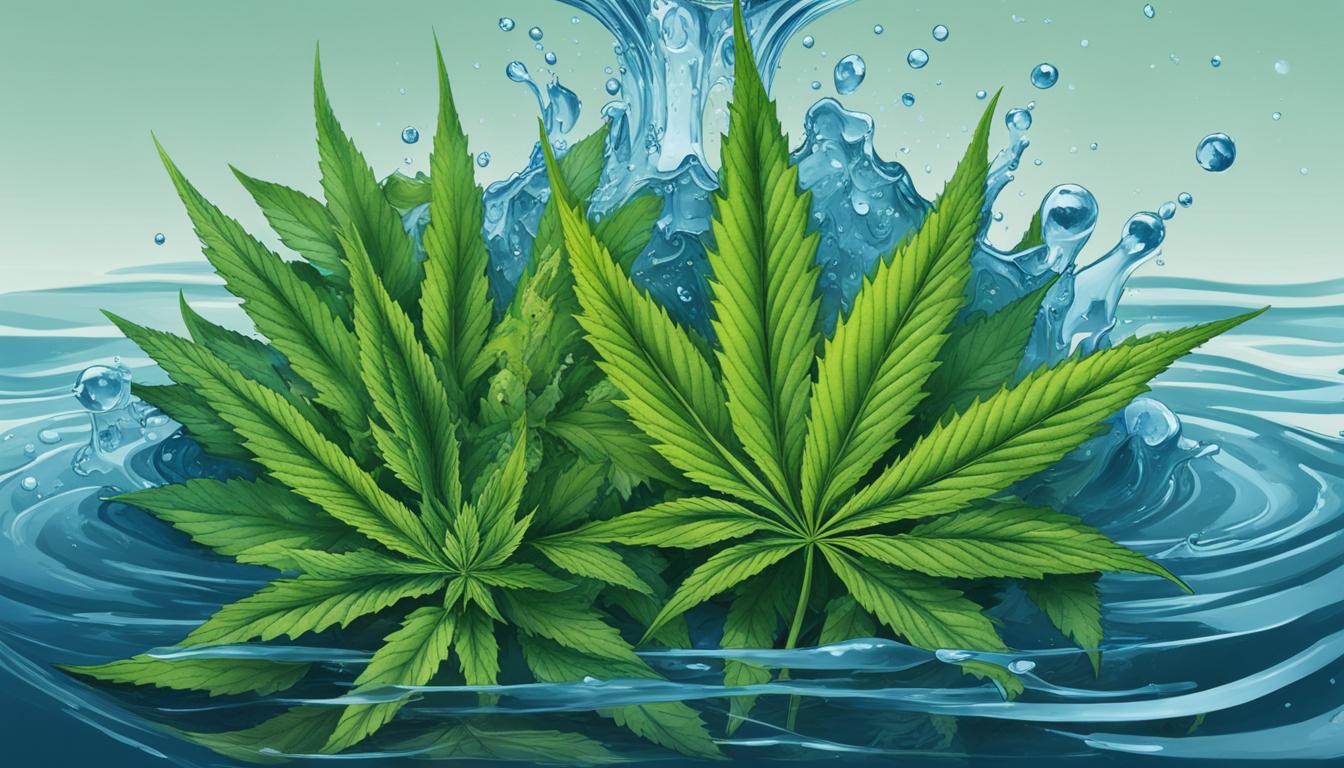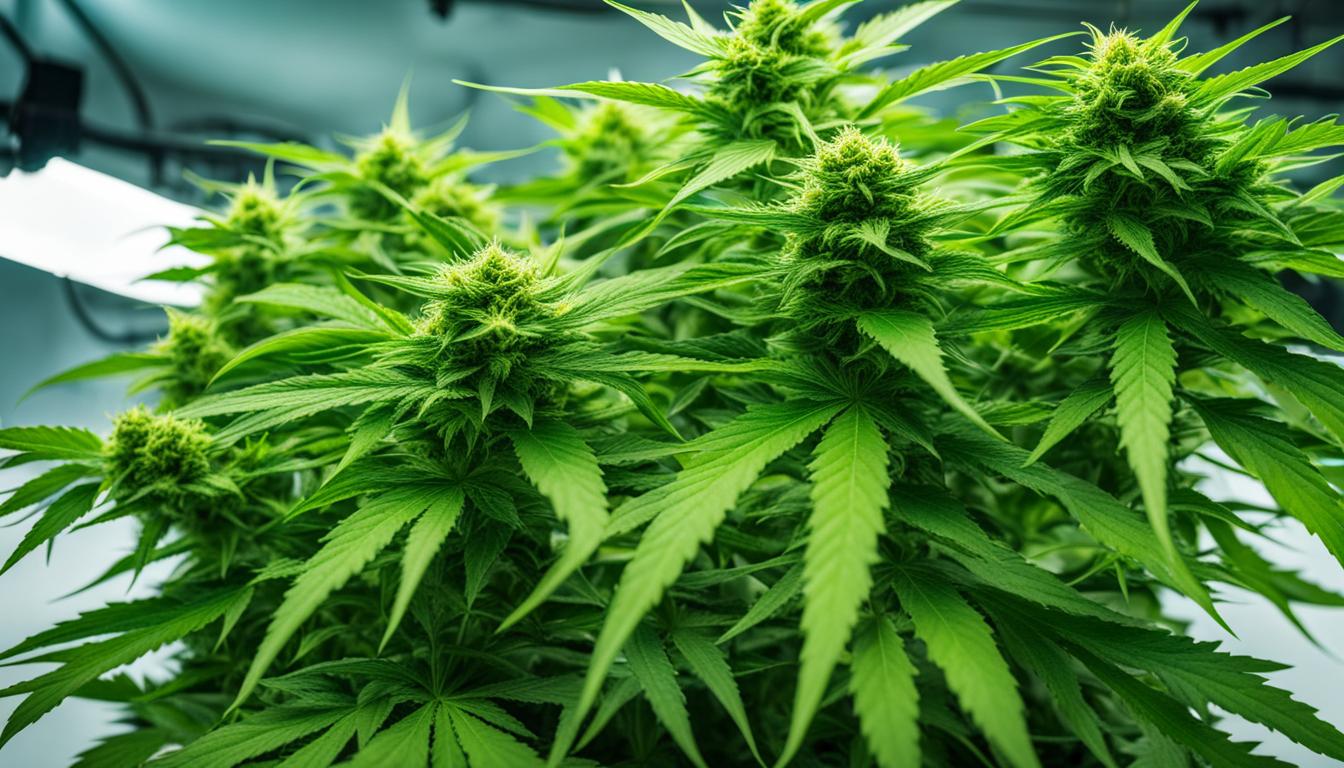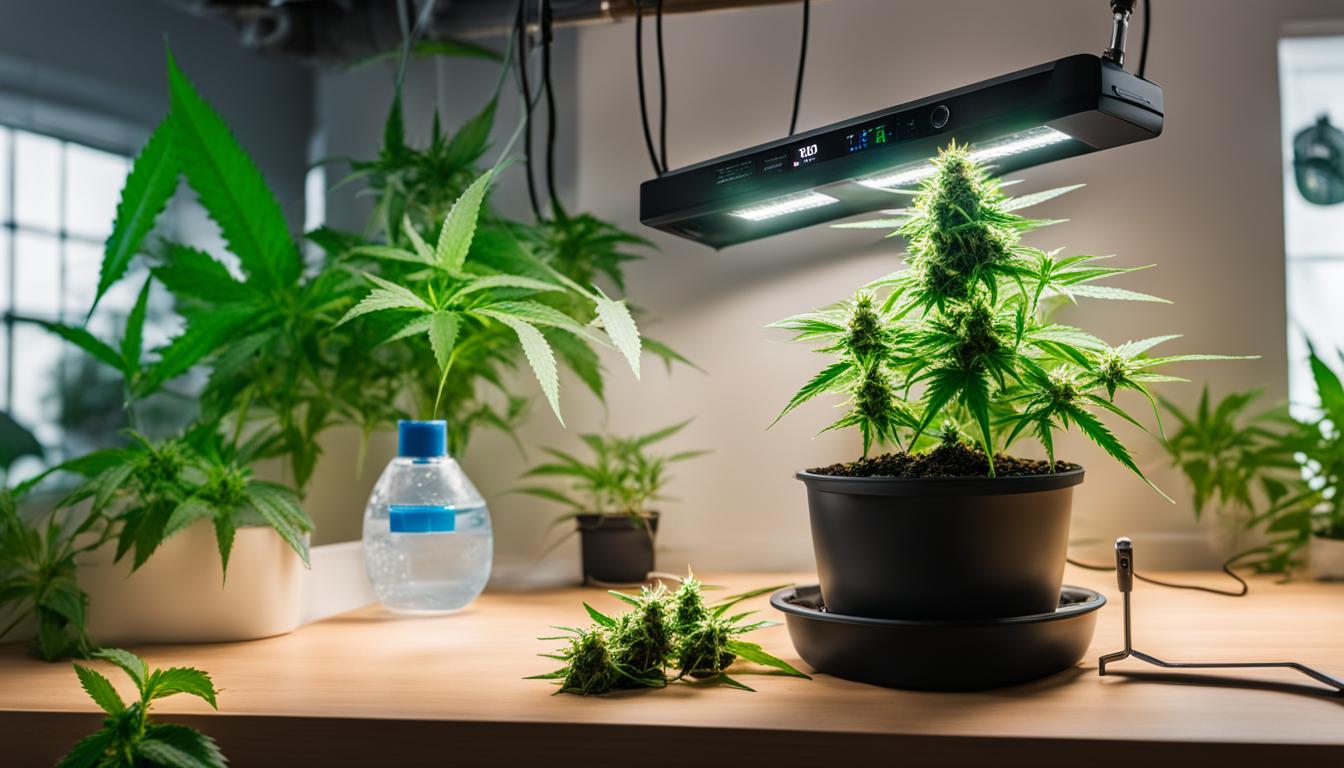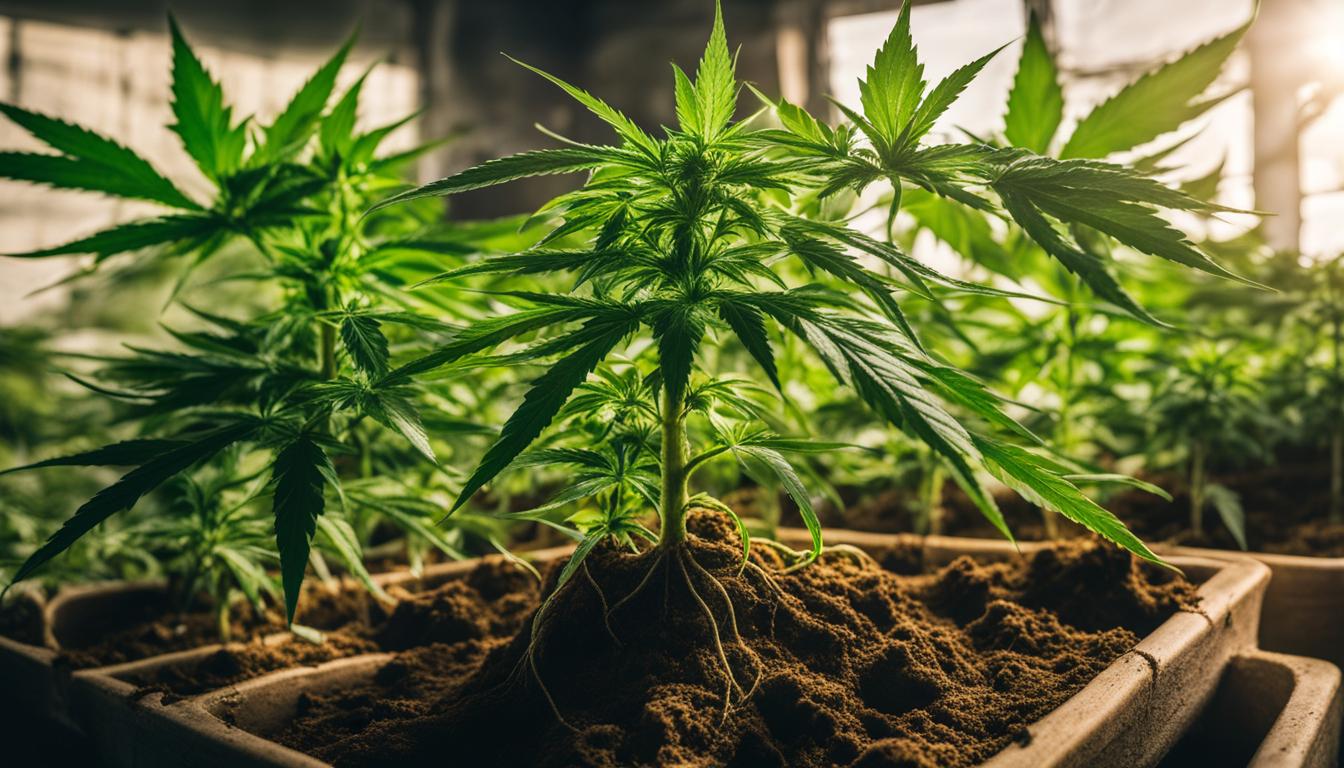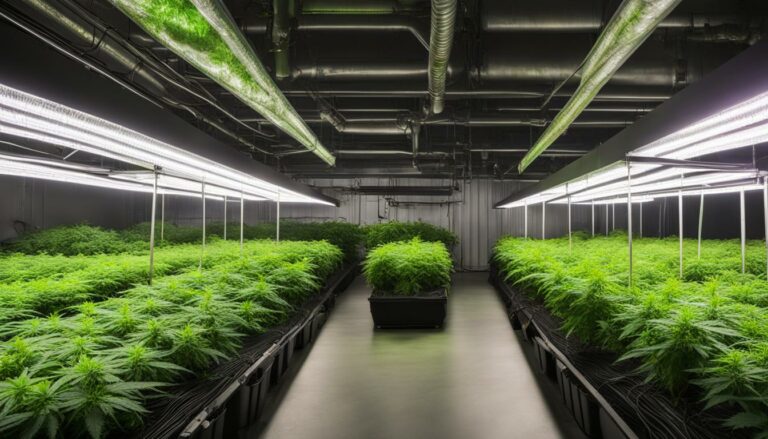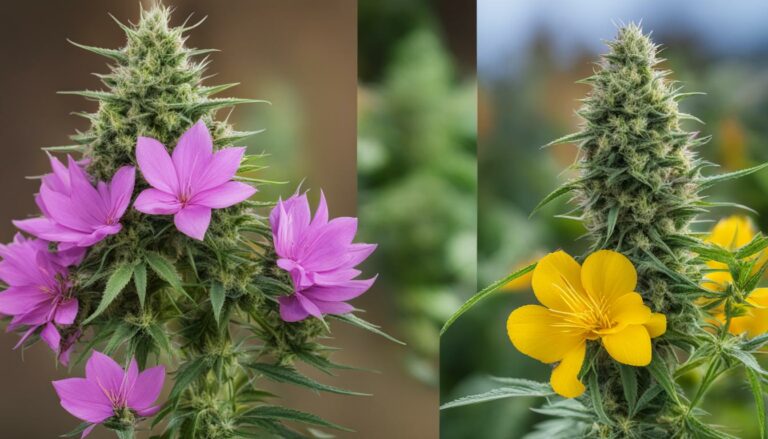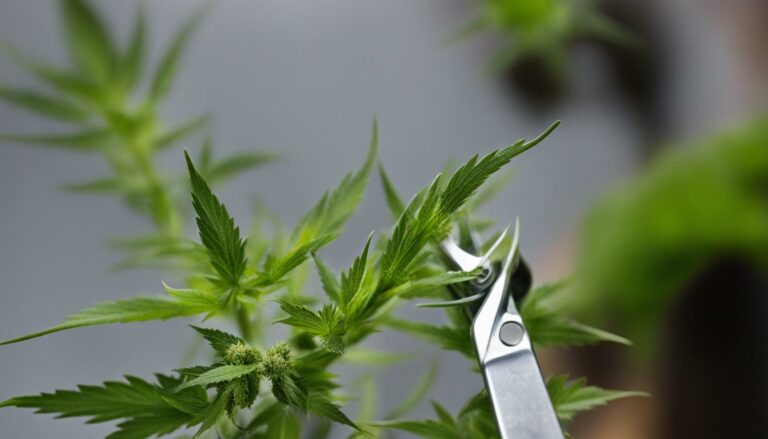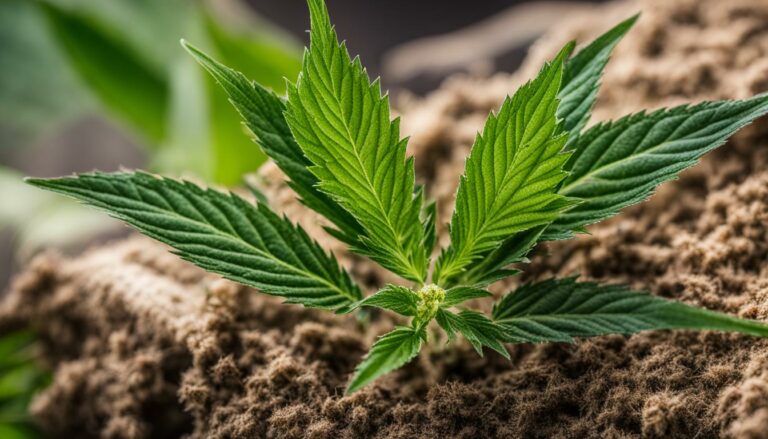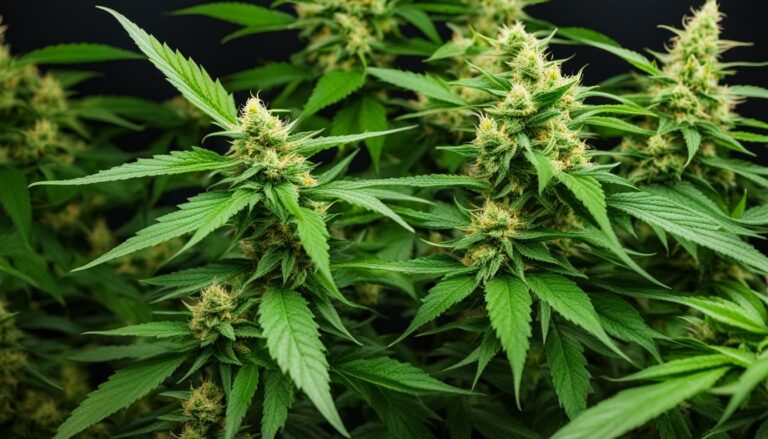The Impact of Water Quality on Cannabis Growth
Welcome to our article on the fascinating relationship between water quality and cannabis growth. In this section, we will explore the crucial role that water quality plays in the cultivation of cannabis plants. From the importance of cannabis water testing to hydroponic water quality control, we will delve into the key factors that contribute to the success of cannabis cultivation.
Understanding Water Demand in Cannabis Cultivation
Cannabis cultivation has a high water demand compared to other crops. On average, a cannabis plant consumes 22.7 liters (6 gallons) of water per day during the growing season. This far exceeds the water needs of many commodity crops like maize, soybean, and wheat. The water demand for cannabis growing is influenced by factors such as geographic location, soil properties, weather conditions, and cultivation methods. Water usage for outdoor cannabis cultivation in California is reported to be 5.5 gallons per day per plant in August and 5.1 gallons per day per plant in September.
In order to meet the water requirements of cannabis plants, cultivators must carefully manage their water resources. Understanding the precise water demand of cannabis cultivation is crucial for sustainable and efficient cultivation practices. By optimizing water usage and implementing water conservation strategies, cultivators can reduce their environmental impact and ensure the availability of water resources for future generations.
Table: Water Demand Comparison (Gallons per day per plant)
| Crop | Water Demand |
|---|---|
| Cannabis | 22.7 |
| Maize | 7.5 |
| Soybean | 2.7 |
| Wheat | 2.3 |
“Cannabis cultivation requires a significant amount of water compared to other crops. It is important for cultivators to understand the water demand and implement sustainable water management practices to minimize their environmental impact.”
Determining Water Requirements for Cannabis Cultivation
Several factors influence the water requirements of cannabis plants. One of the key factors is geographic location. Different regions have varying climates and rainfall patterns, which directly impact the water availability for cultivation. Additionally, the type of soil used and its water holding capacity affect how often and how much water the plants need. Cultivation methods, such as outdoor or indoor growing, also influence water requirements. Indoor cultivation, for example, may require additional water for temperature and humidity control.
“By understanding the factors that influence water demand in cannabis cultivation, cultivators can make informed decisions and implement measures to optimize water usage.”
Being mindful of water demand in cannabis cultivation is vital for sustainable, responsible, and successful cultivation practices. By efficiently managing water resources, cultivators can minimize their environmental footprint and contribute to the long-term viability of the cannabis industry.
The Environmental Impacts of Water Diversion in Cannabis Cultivation
Cannabis cultivation is highly dependent on water, and water diversion is a common practice in the industry. However, this practice can have significant negative impacts on the environment, particularly on aquatic ecosystems and water availability. Surface water diversions for irrigation can lead to reduced flows and dewatered streams, which can disrupt the natural habitat of aquatic species and reduce their population. This is especially concerning for sensitive species like salmonids.
Cannabis cultivation in watersheds can exacerbate the issue of water scarcity, particularly during low-flow periods. By diverting water from natural sources, the availability of water for other uses, such as agriculture or household consumption, can be significantly compromised. This can further aggravate existing water scarcity issues and place additional strain on ecosystems.
To address these environmental concerns, sustainable water management practices in cannabis cultivation are crucial. This includes implementing water conservation measures, such as drip irrigation systems, which minimize water wastage and increase efficiency. Additionally, proper monitoring and regulation of water diversion practices can help minimize the negative impacts on ecosystems and ensure the long-term sustainability of water resources.
| Impacts of Water Diversion in Cannabis Cultivation | Environmental Consequences |
|---|---|
| Reduced flows and dewatered streams | Disruption of aquatic species’ habitats and reduced population |
| Water scarcity during low-flow periods | Increased strain on water resources and ecosystems |
“Water diversion in cannabis cultivation can have significant environmental consequences, impacting aquatic ecosystems and exacerbating water scarcity issues. Sustainable water management practices are essential to minimize these impacts and ensure the long-term viability of the cannabis industry.”
The Importance of Water Conservation in Cannabis Cultivation
Implementing water conservation measures in cannabis cultivation is paramount for minimizing the environmental impacts of water diversion. Drip irrigation systems, for example, deliver water directly to the plants’ roots, reducing wastage and improving overall efficiency. This not only helps conserve water resources but also reduces the strain on ecosystems by minimizing the water withdrawn from natural sources.
By optimizing water use and implementing sustainable cultivation practices, cultivators can contribute to mitigating water scarcity issues and protecting aquatic habitats. This is crucial for maintaining the delicate balance of ecosystems and ensuring the long-term sustainability of cannabis cultivation.
Cannabis Cultivation and Water Scarcity
Water scarcity is a pressing global issue, and the water-intensive nature of cannabis cultivation further exacerbates this problem. The increasing demand for water in cannabis cultivation can strain local water supplies, particularly in regions where water resources are already limited.
Addressing water scarcity in the cannabis industry requires a multi-faceted approach that includes sustainable water management practices, responsible water diversion, and careful consideration of cultivation locations. By adopting these measures, cultivators can minimize their environmental impact, contribute to water conservation efforts, and ensure the long-term sustainability of cannabis cultivation.
Water Pollution Risks in Cannabis Cultivation
Cannabis cultivation can pose significant risks to water quality, with potential consequences for both the environment and public health. The use of fertilizers, pesticides, and other chemicals in cultivation practices can result in water contamination. These pollutants can enter water sources through runoff or leaching, and they can have detrimental effects on humans, crops, and aquatic life. When polluted water is used in irrigation, it can introduce contaminants into the soil, surface water, and groundwater.
The impacts of water pollution in cannabis cultivation can be far-reaching. Pesticides and fertilizers can disrupt the delicate balance of ecosystems, harming beneficial organisms and leading to the decline of native species. Heavy metals, such as lead and cadmium, can accumulate in the soil and be taken up by cannabis plants, posing potential health risks if consumed. Additionally, water pollution can contribute to the degradation of aquatic habitats, threatening the survival of fish, amphibians, and other aquatic organisms.
To mitigate the risks of water pollution in cannabis cultivation, responsible water management practices are crucial. This includes careful selection and application of fertilizers and pesticides, as well as proper disposal of any waste products. Regular water testing and monitoring can help identify potential contaminants and allow for appropriate intervention measures. By implementing these measures, cannabis cultivators can minimize the environmental impact of their operations and ensure the protection of water resources for future generations.
| Risk | Impact |
|---|---|
| Contaminated water sources | Potential harm to human health, crops, and aquatic life |
| Disruption of ecosystems | Decline in native species, disruption of food chains |
| Heavy metal absorption | Potential health risks if contaminated plants are consumed |
| Deterioration of aquatic habitats | Threat to fish, amphibians, and other aquatic organisms |
The Importance of Water Testing
“Water testing is an essential component of responsible cannabis cultivation,” says Dr. Jane Smith, a water quality expert. “Regular testing allows growers to identify any potential contaminants and take appropriate measures to prevent water pollution. It also helps ensure that nutrient levels are optimized, leading to healthier plants and higher yields.”
Regular water testing allows growers to identify any potential contaminants and take appropriate measures to prevent water pollution.” -Dr. Jane Smith
Water testing should be conducted at various stages of cannabis cultivation, from the initial source water to the irrigation water used throughout the growing process. This comprehensive approach helps identify any potential sources of contamination and allows for targeted intervention strategies. By prioritizing water quality testing, cannabis cultivators can demonstrate their commitment to sustainable and responsible cultivation practices.

Water Sources in Cannabis Cultivation
In cannabis cultivation, the availability of water plays a crucial role in ensuring the health and growth of the plants. Cultivators rely on various water sources for irrigation, including surface water and groundwater. Additionally, water diversions are commonly used to meet the high water demands of cannabis cultivation.
Surface water, such as rivers, lakes, and streams, is often utilized as a water source for cannabis irrigation. Growers in areas with abundant surface water resources, such as Humboldt County in California, rely heavily on surface water diversions. Spring diversions, which tap into underground water sources, are also commonly used.
Groundwater, extracted from wells, is another important water source for cannabis cultivation. In areas where surface water availability is limited, growers depend on groundwater to meet their watering needs. Municipal water and rainwater collection systems are additional sources utilized by cultivators to supplement their water requirements.
Understanding the source and availability of water is essential for sustainable cannabis cultivation. By implementing responsible water management practices and utilizing diverse water sources, cultivators can ensure the continued growth of healthy plants while minimizing their impact on local water resources.
“Water diversions and the utilization of diverse water sources are vital for meeting the high water demands of cannabis cultivation while minimizing the impact on local water resources”.
An Example of Water Sources in Cannabis Cultivation
| Water Source | Usage |
|---|---|
| Surface water (rivers, lakes, streams) | Used for irrigation; commonly tapped through surface water diversions |
| Groundwater (wells) | Extracted for irrigation purposes in areas with limited surface water availability |
| Spring diversions | Utilized to tap into underground water sources |
| Municipal water | Supplemental water source in areas with access to public water systems |
| Rainwater collection | Used to collect and store rainwater for irrigation during dry periods |
Impacts of Cannabis Cultivation on Wildlife and Ecosystems

Cannabis cultivation can have far-reaching effects on wildlife and ecosystems. The clearing of land for cultivation can result in habitat loss and fragmentation, disrupting the natural habitats of various species. Forests and grasslands are often cleared to make way for cannabis farms, leading to reduced biodiversity and displacement of wildlife. This habitat loss can disrupt wildlife behavior, migration patterns, and their ability to find food and shelter, putting additional stress on already vulnerable populations.
Water scarcity caused by cannabis cultivation also poses a threat to wildlife and ecosystems. The high water demand of cannabis plants can deplete water sources and reduce stream flows, affecting aquatic species that rely on these habitats. Reduced stream flows can disrupt fish populations, particularly salmonids, and other sensitive aquatic organisms. Additionally, the use of pesticides and fertilizers in cultivation practices can pollute water sources, further endangering aquatic life.
“The clearing of land for cannabis cultivation can have devastating impacts on wildlife and their habitats. We need to adopt sustainable cultivation practices that prioritize environmental conservation.”
These impacts highlight the need for sustainable and responsible cultivation practices. By implementing measures to minimize habitat loss, such as practicing land restoration and utilizing existing agricultural areas, cultivators can mitigate the negative effects on wildlife and ecosystems. Moreover, adopting water conservation practices and implementing proper water management strategies can help reduce the strain on water resources, ensuring the availability of water for both cultivation and the surrounding environment.
Table: Impacts of Cannabis Cultivation on Wildlife and Ecosystems
| Impact | Description |
|---|---|
| Habitat loss and fragmentation | Clearing land for cultivation disrupts natural habitats and can displace wildlife. |
| Disruption of wildlife behavior and migration patterns | Loss of habitats can alter wildlife behavior and impact their ability to migrate, find food, and reproduce. |
| Reduction in biodiversity | Habitat loss and fragmentation contribute to a decline in species diversity and abundance. |
| Water scarcity and its impacts on aquatic species | High water demand in cultivation reduces water availability for aquatic species, affecting their survival and reproduction. |
| Water pollution and contamination | The use of pesticides and fertilizers in cultivation practices can contaminate water sources, endangering aquatic life. |
With a growing global cannabis industry, it is crucial to prioritize sustainable cultivation practices that minimize the impact on wildlife and ecosystems. By implementing eco-friendly approaches and embracing conservation efforts, we can ensure a harmonious coexistence between cannabis cultivation and the natural environment.
The Impact of Energy Consumption in Indoor Cannabis Cultivation
Indoor cannabis cultivation is renowned for its ability to provide controlled growing conditions, but it comes at a cost. The energy consumption associated with indoor cannabis cultivation is significant and can have detrimental environmental consequences. The use of artificial lighting, heating, ventilation, and air conditioning systems contributes to increased electricity consumption and higher levels of greenhouse gas emissions.
According to studies, indoor cannabis cultivation can consume up to 2,000 kilowatt-hours of electricity per pound of product. To put this into perspective, the average U.S. household consumes approximately 10,400 kilowatt-hours of electricity per year. This high energy demand not only contributes to carbon emissions but also puts a strain on the electrical grid, especially in regions with a dense concentration of indoor cultivation facilities.
Reducing energy consumption in indoor cannabis cultivation is crucial for sustainable and responsible practices. Cultivators can implement various strategies to minimize their carbon footprint, such as using energy-efficient lighting systems, optimizing HVAC systems for better energy management, and incorporating renewable energy sources like solar power. Adopting these strategies not only helps mitigate the environmental impact but also reduces operating costs in the long run.
| Indoor Cultivation | Outdoor Cultivation | |
|---|---|---|
| Energy Consumption | High | Low |
| Carbon Footprint | Significant | Minimal |
| Electricity Demand | Intensive | Low |
Indoor cannabis cultivation is energy-intensive due to the use of artificial lighting, heating, ventilation, and air conditioning systems.
Key Points:
- Indoor cannabis cultivation consumes a significant amount of energy and contributes to greenhouse gas emissions.
- Energy-efficient practices and the use of renewable energy sources can help reduce the environmental impact of indoor cultivation.
- Comparatively, outdoor cultivation has lower energy consumption and a minimal carbon footprint.
As the cannabis industry continues to grow, it is essential for cultivators to prioritize sustainable energy practices. By embracing energy-efficient technologies and renewable energy sources, indoor cannabis cultivation can become more environmentally friendly and economically viable in the long term.

Soil Erosion and Heavy Metal Absorption in Cannabis Cultivation
Cannabis cultivation can have unintended consequences on soil health, including increased soil erosion and the potential absorption of heavy metals by cannabis plants. The process of clearing land for cultivation can lead to soil disturbance and erosion, resulting in the loss of topsoil and essential nutrients. This can have long-term effects on soil quality and fertility, impacting the sustainability of cannabis growing practices.
Furthermore, cannabis plants have the ability to absorb heavy metals from the soil. Heavy metals can be naturally present in soil or introduced through human activities such as the use of contaminated water sources or the application of certain fertilizers and pesticides. The absorption of heavy metals by cannabis plants can pose risks to human health if the contaminated plants are consumed.
To mitigate these risks and ensure the long-term viability of cannabis cultivation, it is crucial to implement proper soil management practices. Erosion control measures, such as the use of cover crops and contour plowing, can help minimize soil erosion and protect valuable topsoil. Regular soil testing is also essential to monitor heavy metal levels and identify any potential contamination issues. This allows growers to take appropriate actions to remediate soil and prevent further absorption by cannabis plants.
| Soil Management Practices | Benefits |
|---|---|
| Implement erosion control measures such as cover cropping and contour plowing | Minimizes soil erosion and loss of topsoil |
| Regular soil testing | Identifies heavy metal levels and contamination issues |
| Remediation of contaminated soil | Prevents further absorption of heavy metals by cannabis plants |
Soil erosion and heavy metal absorption in cannabis cultivation can have detrimental impacts on soil health and human health. By implementing proper soil management practices and regular testing, cultivators can protect soil quality and ensure the safety of their crops.
Summary:
- Cannabis cultivation can lead to soil erosion and the potential absorption of heavy metals by plants.
- Soil erosion can result from land clearing practices, causing the loss of topsoil and essential nutrients.
- Cannabis plants have the ability to absorb heavy metals from the soil, posing risks to human health if contaminated plants are consumed.
- To mitigate these risks, growers should implement erosion control measures, regularly test soil for heavy metal levels, and remediate contaminated soil.
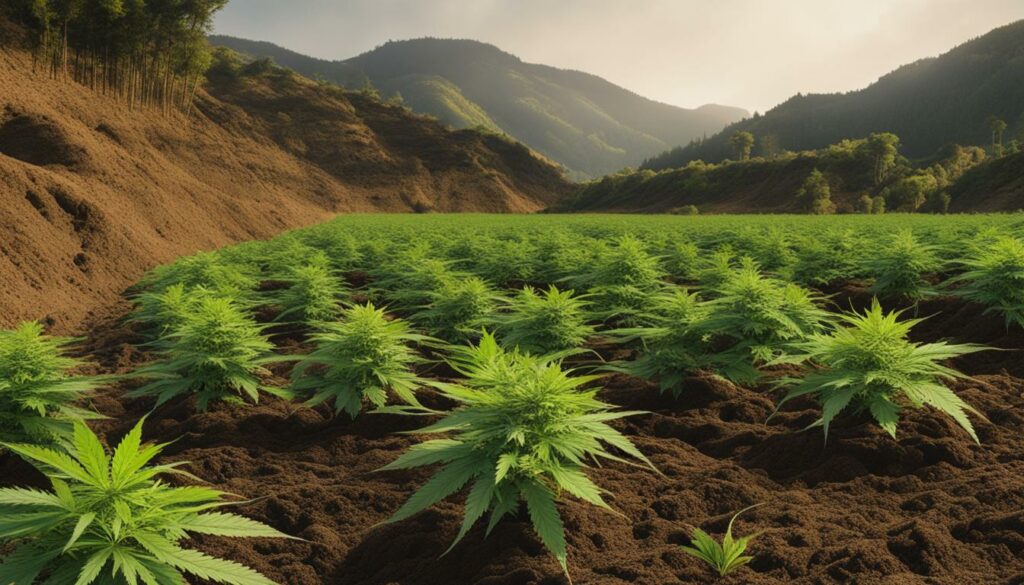
The Role of Precision Irrigation and Water Conservation in Cannabis Cultivation
Precision irrigation techniques and water conservation practices play a crucial role in sustainable cannabis cultivation. By implementing these strategies, cultivators can optimize water use, reduce environmental impact, and ensure long-term water resource sustainability.
Precision irrigation, such as drip irrigation, offers several advantages over traditional irrigation methods. It delivers water directly to the plants’ root zones, minimizing water wastage and improving water efficiency. This targeted approach ensures that plants receive the necessary moisture without excess runoff or evaporation, reducing water consumption and associated costs. Additionally, precision irrigation helps prevent waterlogging and allows for precise control of nutrient delivery, enhancing plant health and yield.
Water conservation practices are equally important in cannabis cultivation. Collecting and storing rainwater can supplement irrigation needs and reduce reliance on other water sources. Rainwater harvesting systems capture rainfall from rooftops or other catchment areas, storing it for future use. This sustainable practice not only conserves water but also reduces the strain on local water supplies. Cultivators can also adopt innovative technologies such as sensor-based irrigation systems, which monitor soil moisture levels and adjust irrigation accordingly, optimizing water usage.
“Precision irrigation and water conservation are key to sustainable water management in cannabis cultivation. By adopting these practices, cultivators can minimize water waste, protect local water resources, and contribute to the overall sustainability of the industry.”
Furthermore, implementing efficient water management strategies can help mitigate the environmental impact of cannabis cultivation. Excessive water use can contribute to water scarcity, especially in regions prone to drought or with limited water availability. By conserving water and utilizing precision irrigation, cultivators can reduce their ecological footprint and promote responsible water stewardship.
In conclusion, precision irrigation and water conservation are essential components of sustainable cannabis cultivation. These practices optimize water use, reduce environmental impact, and contribute to long-term water resource sustainability. By prioritizing precise water delivery and adopting conservation measures, cultivators can minimize water waste, protect local water resources, and cultivate cannabis in an environmentally responsible manner.

The Importance of Monitoring and Testing Cannabis Water Quality
Cannabis cultivators must prioritize the monitoring and testing of water quality to ensure the health and safety of their plants. Regular testing and analysis of cannabis water is crucial to identify potential contaminants and maintain optimal nutrient levels for plant growth. By implementing robust water quality control measures, cultivators can minimize the risk of water contamination and optimize the overall health and productivity of their crops.
Water quality analysis in cannabis growing is essential for several reasons. Firstly, it helps identify the presence of pesticides, fertilizers, heavy metals, and other pollutants that can be harmful to both the plants and the environment. By detecting these contaminants early on, cultivators can take appropriate measures to prevent their introduction and minimize the potential risks associated with their use.
Secondly, monitoring and testing water quality allows for the optimization of nutrient levels. Cannabis plants require specific nutrients at different stages of growth, and maintaining the correct nutrient balance is critical for healthy plant development. By regularly testing the water, cultivators can adjust nutrient levels accordingly, ensuring that the plants receive the proper nourishment to thrive.
Lastly, monitoring cannabis water quality helps cultivators maintain the overall health and vitality of their plants. Poor water quality can lead to a range of issues, including stunted growth, nutrient deficiencies, and increased susceptibility to diseases and pests. Regular testing allows cultivators to identify and address water quality issues promptly, ensuring that their plants have the best possible growing conditions.
The Importance of Water Quality Analysis
Water quality analysis is not only crucial for the well-being of cannabis plants but also for the sustainability and responsibility of the cultivation process. By implementing effective water quality control measures, cultivators can minimize their environmental impact and contribute to the long-term viability of the cannabis industry. Responsible cultivation practices, including regular water testing, help protect water resources, reduce the risk of water pollution, and ensure the continued availability of clean water for future generations.
Related Articles
- How Does Water Quality Affect Cannabis Plant Health?
- What Are the Best Watering Practices for Cannabis Cultivation?
- How to Test and Adjust Water pH for Cannabis Plants?
- Can Hard Water Harm Cannabis Plants and How to Treat It?
- What Are the Signs of Overwatering and Underwatering in Cannabis?
Conclusion
Water quality is of utmost importance in the sustainable cultivation of cannabis. The impact of water quality on cannabis growth cannot be understated. By prioritizing water quality and adopting responsible cultivation practices, we can ensure the long-term viability of the cannabis industry and protect the environment.
Sustainable cannabis cultivation practices, such as precision irrigation and water conservation, are key to minimizing the industry’s ecological footprint. By implementing these strategies, cultivators can optimize water usage, reduce waste, and contribute to the overall health of the plants.
Proper soil management and regular water testing are also crucial. Monitoring and testing the quality of cannabis water can help identify potential contaminants and optimize nutrient levels, ensuring the health and safety of the plants. By taking these proactive measures, cultivators can prevent water pollution and protect the ecosystems surrounding cultivation sites.
In conclusion, sustainable cannabis cultivation practices that prioritize water quality are essential for the industry’s future. By embracing environmentally-friendly techniques and monitoring water quality, we can minimize our impact on ecosystems, preserve water resources, and cultivate cannabis in a responsible and sustainable manner.
FAQ
What is the water demand in cannabis cultivation compared to other crops?
Cannabis cultivation has a high water demand compared to many other crops. On average, a cannabis plant consumes 22.7 liters (6 gallons) of water per day during the growing season, which is significantly higher than crops like maize, soybean, and wheat.
How much water is used for outdoor cannabis cultivation in California?
In California, water usage for outdoor cannabis cultivation is reported as 5.5 gallons per day per plant in August and 5.1 gallons per day per plant in September.
What are the environmental impacts of water diversion in cannabis cultivation?
Water diversion in cannabis cultivation can lead to reduced flows and dewatered streams, threatening aquatic habitats and wildlife. It can also contribute to water scarcity in areas where cannabis cultivation is prevalent.
What are the risks of water pollution in cannabis cultivation?
Water pollution in cannabis cultivation can occur through the use of fertilizers, pesticides, and other chemicals. Runoff or leaching of these substances can contaminate water sources and pose threats to humans, crops, and aquatic life.
What are the primary water sources for cannabis cultivation?
Cannabis cultivation relies on various water sources, including surface water, groundwater, well water, municipal water, and rainwater. The distribution of water sources can vary depending on the location.
How does cannabis cultivation impact wildlife and ecosystems?
The clearing of habitats for cannabis cultivation can result in habitat loss and fragmentation, disrupting wildlife behavior and migration patterns. Water scarcity caused by cannabis cultivation can also harm fish populations, amphibians, and other aquatic organisms.
How does indoor cannabis cultivation impact energy consumption?
Indoor cannabis cultivation is energy-intensive due to the use of artificial lighting, heating, ventilation, and air conditioning systems. This high energy demand contributes to greenhouse gas emissions and the carbon footprint of the industry.
How does cannabis cultivation contribute to soil erosion and heavy metal absorption?
The removal of vegetation and disturbance of soil during cannabis cultivation can increase erosion rates and sediment delivery to water bodies. Additionally, cannabis plants have the ability to absorb and store heavy metals from the soil, which can pose risks to soil quality and human health.
What are precision irrigation and water conservation techniques in cannabis cultivation?
Precision irrigation, such as drip irrigation, delivers water directly to the plants’ root zones, reducing water wastage and improving efficiency. Water conservation practices, such as collecting and storing rainwater, also contribute to sustainable water management in cannabis cultivation.
Why is monitoring and testing cannabis water quality important?
Regular water testing helps identify potential contaminants, optimize nutrient levels, and maintain plant health. It is crucial for preventing water contamination and ensuring the long-term sustainability of cannabis cultivation.

